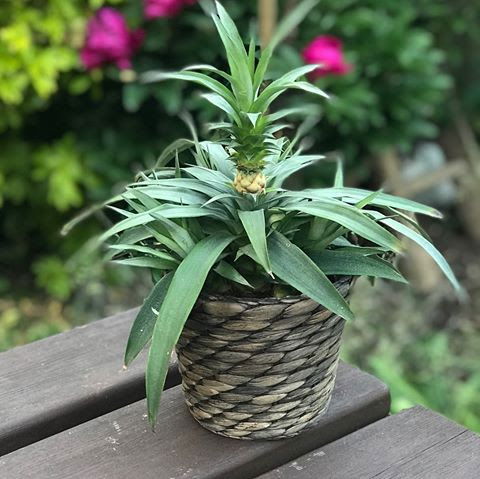
Ananas comosus
Contents
- Top Tips
- Location, Water, Humidity & Fertilisation
- Common Issues
- Origins, Temperature, Propagation, Repotting & Toxicity.
Need the answer to a specific plant query? Book a 1-to-1 video call with THE HOUSEPLANT DOCTOR™, the website's friendly author, to overcome and address your niggling problem! Available on iMessage, WhatsApp, Facebook Messenger & more.
Top Tips & Info
- Care Difficulty - Easy to Moderate
- Provide a bright location with several hours of direct sun per day. Especially in the height of summer, be sure to keep on top of compost moisture as sun-scorch and dehydration are a common issue among growers.
- Allow the soil's top third to dry out in between waters, significantly reducing this in the autumn and winter months.
- Fertilise using a 'Houseplant' labelled feed every four waters in the spring and summer, reducing this to every six in the colder months. While the specimen is in fruit, swap for a product high in potassium to improve the yield's quality, still at monthly intervals. A good example would be 'tomato feed'.
- It's good to note that the Pineapple Plant offshoots don't have to be propagated. As the offsets grow (known as 'pups'), they'll use the mother plant's root system to uptake water and nutrients, which in turn will make them grow quicker than when separated. Pineapple Plants are a 'family species' where a mother plant can live in harmony with her 'pups'.
- Repot every three years using a 'Cactus & Succulent' compost to avoid the high risk of root rot with more water-retentive soils.
- Got a green pineapple that won't turn orange? Keep the fruit attached to the plant & feed with a potassium-based feed (Tomato feed is great!) to speed this process. Hang in there!
- Flowers & Fruits - As each individual plant will only flower/fruit once, you'll have to wait until the 'pups' or 'slips' (offsets) reach maturity for another bloom/pineapple. It's unlikely that a domestically grown specimen will develop a fruit due to its unfavored growing conditions. If, however, you are looking to attempt a further yield, scroll down to the 'Flowers' section to learn more!
Location & Light - 🔸🔸🔸
Provide a good amount of sunlight per day, especially in the winter months while daylight is to a minimal. Shadier locations around the house should be avoided at all costs as the slowed rates of drying compost will cause several issues down the line, including heart rot and southern blight.
Water - 🔸🔸
Rehydrate once the soil's top third dries out in between waters, reducing this further in the autumn and winter. Under-watering symptoms include the yellowing or greying of foliage, stunted growth and a gradual decline of health; these issues are typically caused by too much sunlight or heat, high winds or forgetfulness with the hydrations. Over-watering symptoms include yellowing older leaves, mouldy compost, a rotten stem, soft fruit and plantlet death. It's always better to under-water a Pineapple Plant than over-do it due to its impressive ability to withstand short-lived droughts. For those who feel that root rot has fully taken over, be sure to read around the situation via this link.
Humidity - 🔸🔸🔸
Create a humidity tray to provide a moist and stable environment for your plant. If the surrounding saturation is too low or the heat too high, its leaf-tips may start to brown over and curl, especially in direct sunlight. Hose the foliage down from time to time to hydrate the leaves and keep the dust levels down.
Fertilisation - 🔸🔸
Fertilise every four waters during the growing period before reducing this to every six in the autumn & winter. If your specimen is in fruit, we recommend swapping this for a feed high in potassium for the better development of fruit. An excellent example of this would be tomato food or a 'Flowering-Plant Fertiliser'.
Common Issues with Pineapple Plants
If your plant is lacking a pineapple, this could be caused by a too-warm winter, where the temperatures are kept more or less the same over the year. Reduce the temperature by a couple of degrees over the autumn and winter months, along with fewer irrigations to ensure a well-spent dormancy. A good temperature to aim for is around 12-15℃ (54-59℉).
Yellowing older leaves (closest to soil) and crown rot are a clear sign of over-watering, usually caused by too little light. People don't realise that a plant's root system needs access to oxygen too; when soil is watered, the air will travel upwards and out of the potting mix. A lack of accessible oxygen for the roots will cause them to subsequently breakdown over the oncoming days. Click on this link to learn more about root rot and how to address it.
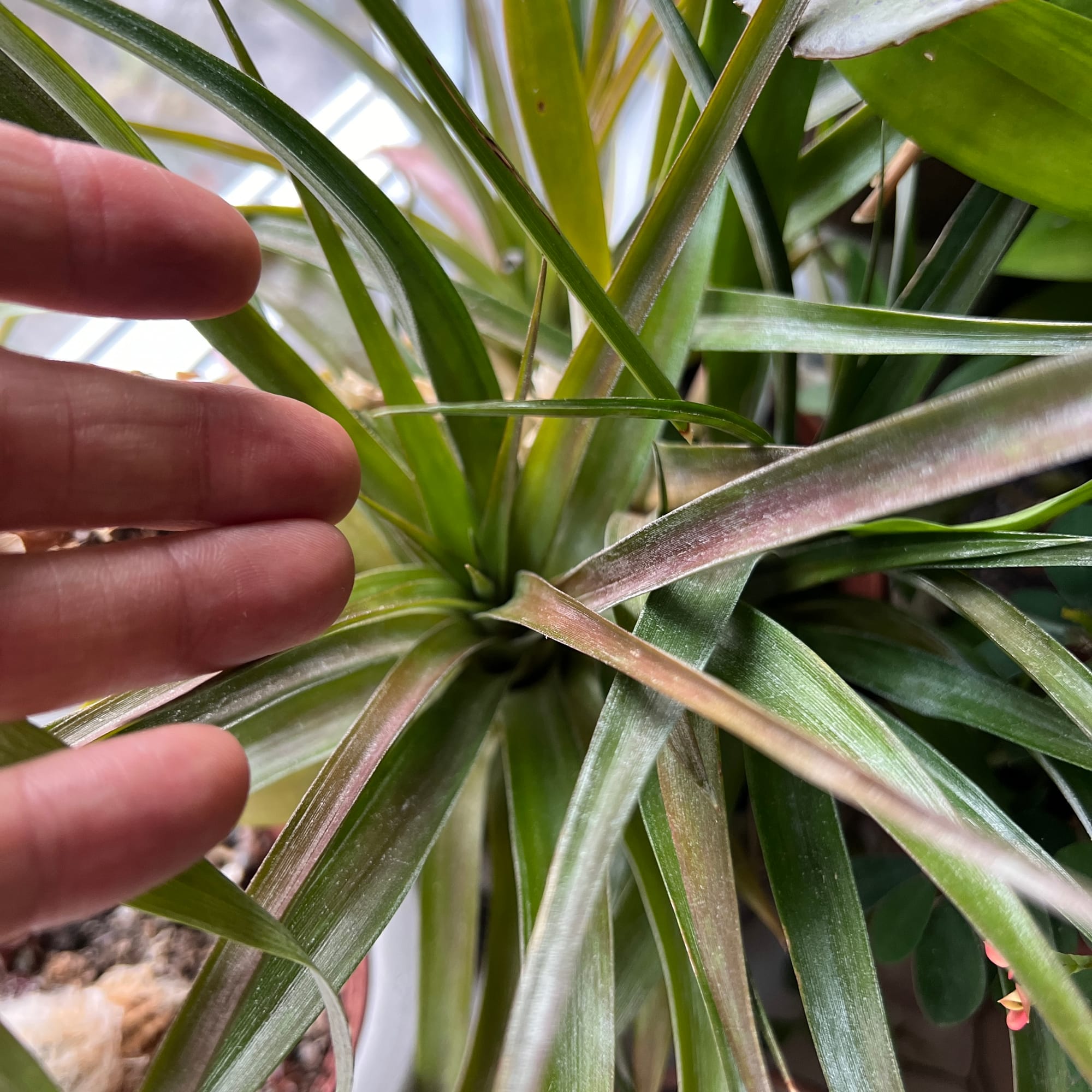 Curled, red or brown leaves are the result of too little water and over-exposure to the sun. Although Pineapple Plants can naturally do well in sun-filled locations, those that haven't acclimatised to the harsh rays will show signs of sun-scorch and environmental shock. Gradually increase the amount of light every few days, starting from an indirect location to a few hours of morning/evening sun over a few weeks. Prolonged exposure will significantly speed the process of dehydration, so consider transplantation into a bigger pot in the spring to wrap the roots around moister soil.
Curled, red or brown leaves are the result of too little water and over-exposure to the sun. Although Pineapple Plants can naturally do well in sun-filled locations, those that haven't acclimatised to the harsh rays will show signs of sun-scorch and environmental shock. Gradually increase the amount of light every few days, starting from an indirect location to a few hours of morning/evening sun over a few weeks. Prolonged exposure will significantly speed the process of dehydration, so consider transplantation into a bigger pot in the spring to wrap the roots around moister soil.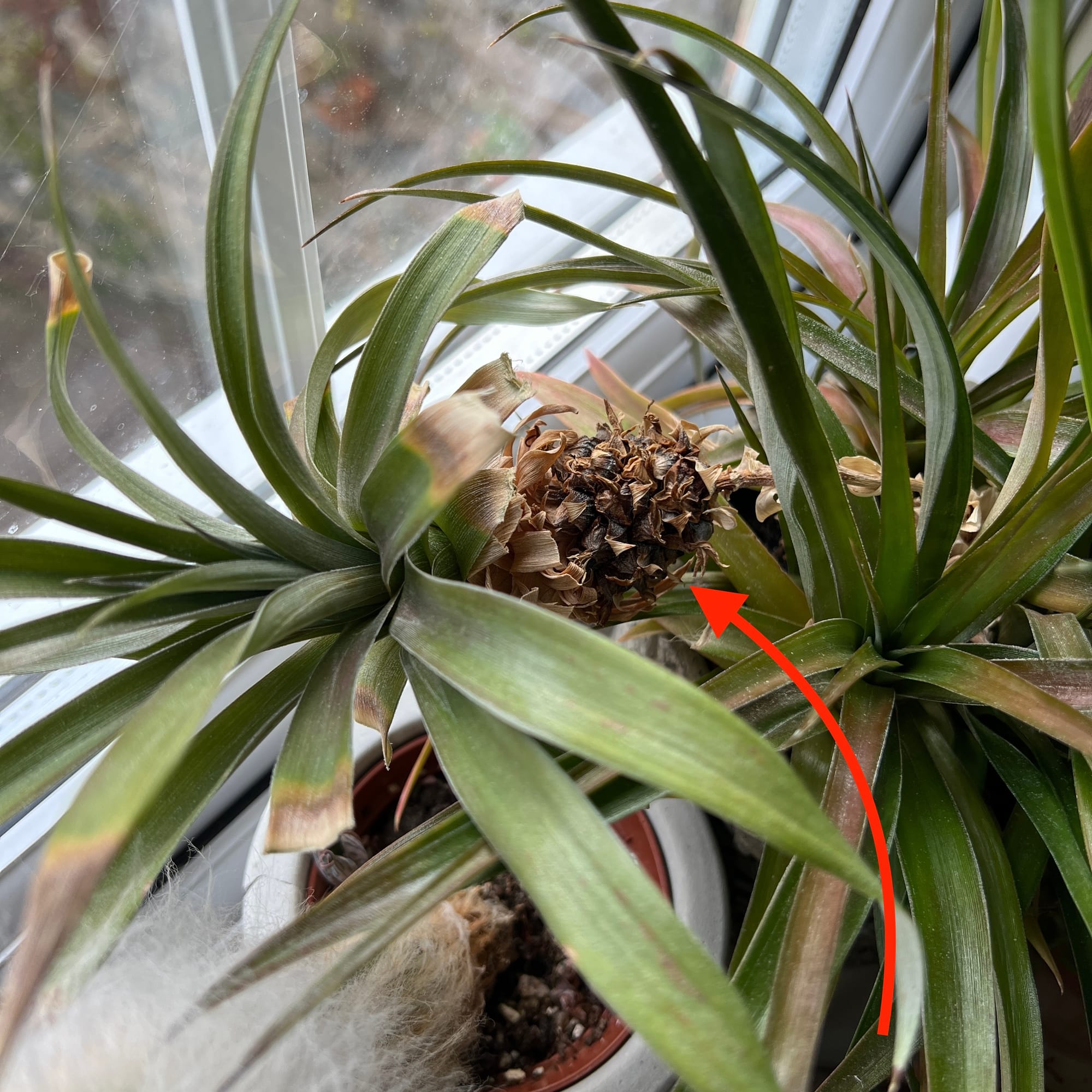
Eventually, the Pineapple at the top will die around 6-12 months after it was purchased. You can keep the pineapple on to dehydrate, where it'll then produce another growth on top - scroll down to 'Propagation' to learn more.
Will my Pineapple Plant produce another pineapple? Yes! A new fruit will develop from one of the 'pups' (offshoots) at the mother plant's base. It may take up to four years before you see another pineapple though...
Mould developing on the soil means two things - too little light and over-watering. Despite the harmlessness, it'll prove unsightly to most gardeners and is therefore removed once known. To remove, replace the top two inches of the soil for a fresh batch of 'Cactus & Succulent' compost. Either increase the amount of light received (no direct sunlight for the first few weeks to prevent environmental shock) or decrease the frequency of waters slightly. If the mould is accompanied by yellowing lower leaves, you may also have a case of root rot.
Origins
Christopher Colombus first discovered the Pineapple Plant back in 1493 during a voyage to Leeward island of Guadeloupe, initially noting the species as piña de Indes ("Pine of the Indians"). Since its discovery, the fruit has been introduced to many regions of the world, including India (15th century) and the Philippines, Hawaii, Guam and Zimbabwe in the 18th-century. The term 'pineapple' came from the initial resemblance to the pinecone when European explorers re-described the species in 1664. The binomial name, Ananas comosus, comes from the Tupi word for 'excellent fruits', with comosus meaning 'tufted' that refers to the fruits' stem.
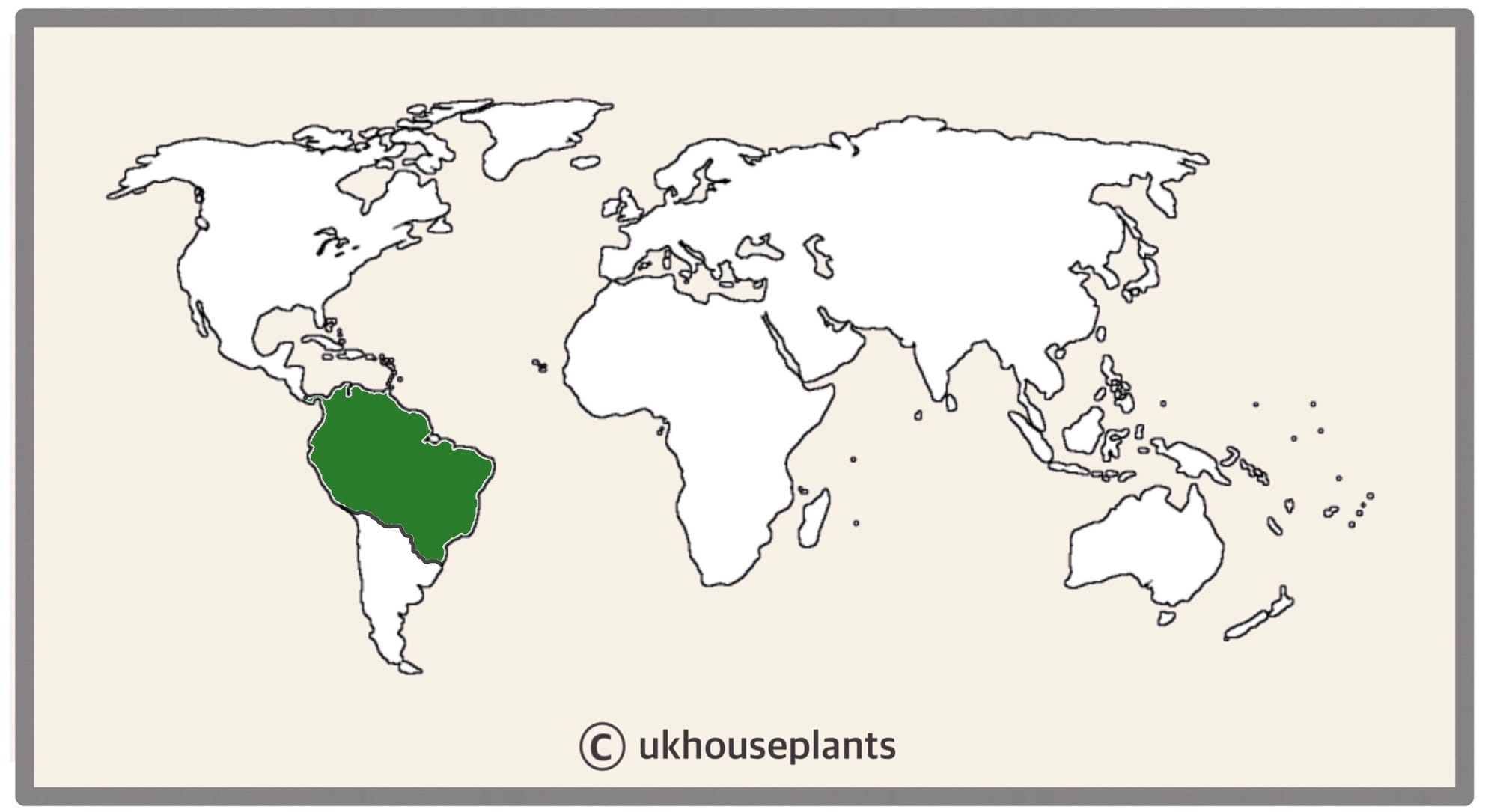 The Distribution of Ananas comosum
The Distribution of Ananas comosum
Temperature
8° - 30°C (46 - 86°F)
H1c (Hardiness Zone 11) - Can be grown outdoors between late spring and summer throughout most of the UK while nighttime temperatures are above 8℃ (46℉). If you decide to bring the plant outdoors, don't allow it to endure more than an hour of direct sunlight a day as it may result in sun-scorch. Regularly keep an eye out for pests, especially when re-introducing back indoors.
Spread
Up to 50cm in height and 40cm in width, with maturity being reach in around 8 years. Growth rates are particularly slow, especially with newly-propagated pups or diseased specimens.
Pruning & Maintenance
Remove yellow or dying leaves, and plant debris to encourage better-growing conditions. While pruning, always use clean utensils or shears to reduce the chance of bacterial and fungal diseases. Never cut through yellowed tissue as this may cause further damage in the likes of diseases or bacterial infections. Remember to make clean incisions as too-damaged wounds may shock the plant, causing weakened growth and a decline in health.
Remove the flower stalk close to the plant's well once it begins to wilt, keeping the well dry from there on in. If the open tissue from the stalk's base remains submerged in water, it could result in rot that may spread to the rest of the plant if untreated.
Propagation
Via Seed or 'Pup' Propagation.
Basal Offset Division ('Pups') (Easy) - Your plant will produce several basal offsets (known as 'pups') that can be separated once they have a sufficient root system and surpass the mother plant's height by half. If possible, water the soil 24hrs before the main event to reduce the risk of transplant shock, when its dry root systems are over-touched. Take the plant out of its pot and place your fingers close to the nodal junction - compost may have to be removed for better access. Push the chosen offset downwards until you hear a snap. Separate the foliage and its root system away from the mother plant, mentally noting the high risk of damage. Transplant in the appropriate sized pot with a fresh batch of 'Cactus & Succulent' compost. If the propagated pup doesn't have a root system yet, you must wrap the plant (& its pot) wholly in a plastic bag after watering the soil. This will both keep the soil moist for longer and will increase the likelihood of rooting (which is important for the pup's survival!). Check for dry soil by opening the bag once every week and water if necessary. Keep the potted pup (still in its bag) it in a bright, indirect windowsill away from any direct sunlight. After three months, remove the bag and treat it like a mature plant, following the care tips above!
For Crown Propagation (Moderate), choose a pineapple from the local store that still has it's central intact (i.e. those with spiky green growth directly at in the well/crown). Brown leaf-tips shouldn't be much of an issue, as long as it hasn't travelled to the core. While using a clean knife, make a clear, straight cut exactly between the fruit and the foliaged-crown - discard if there is a brown core. Place the bottom quarter into lukewarm water, avoiding submersion the whole piece for hygiene and anaerobic reasons. After several weeks, you should observe little white root-heads developing on the wound, and once they are 3cm (1.1 inches) in length, transplant the bottom quarter into a 'Cactus & Succulent' compost. Maintain evenly moist soil and situate it in a bright, indirect location away from any direct sunlight. After twelve weeks, treat it like a healthy specimen, following the care tips above!
 A rooted pineapple plant pup that's roughly about a year old.
A rooted pineapple plant pup that's roughly about a year old.
Flowers & Fruits
The individual Pineapple plant will only fruit once, but as mentioned above, offsets will form between the lower leaves that'll eventually produce their own fruit in years to come. Its fruit can be up to 40cm in length and should last for around three months in the correct environment. Unfortunately, due to the unfavored growing conditions of too little light and temperature fluctuations, a recently-purchased Pineapple won't grow much larger and therefore should be admired by its current size.
How to Achieve a New Pineapple to Grow in the Future
With a matured plant of several years, reduce its autumn and winter temperature to around 10℃ (50℉) with much sun, little water and fertilisation. Maintain a good level of light throughout this period, increasing hydrations as the ambient temperature once the springtime returns. Fertilise every fortnight using a potassium-based feed and play the waiting time; flowers will develop from its centre that'll slowly formate into a fruit within a few months. It's a difficult process to master, but most specimens could eventually flower/fruit with given time.
Repotting
Repot every three years in the spring, using a 'Cactus & Succulent' compost and the next sized pot with adequate drainage. Hydrate the plant 24hrs before tinkering with the roots to prevent the risk of transplant shock. Add a thin layer of small grit in the pot's base to improve drainage and downplay over-watering. Click here for a detailed step-by-step guide on transplantation, or via this link to learn about repotting with root rot.
Book a 1-to-1 video call with THE HOUSEPLANT DOCTOR™ if you'd like a personal guide to repotting your houseplant. This will include recommending the right branded-compost and pot size, followed by a live video call whilst you transplant the specimen for step-by-step guidance and answer any further questions!
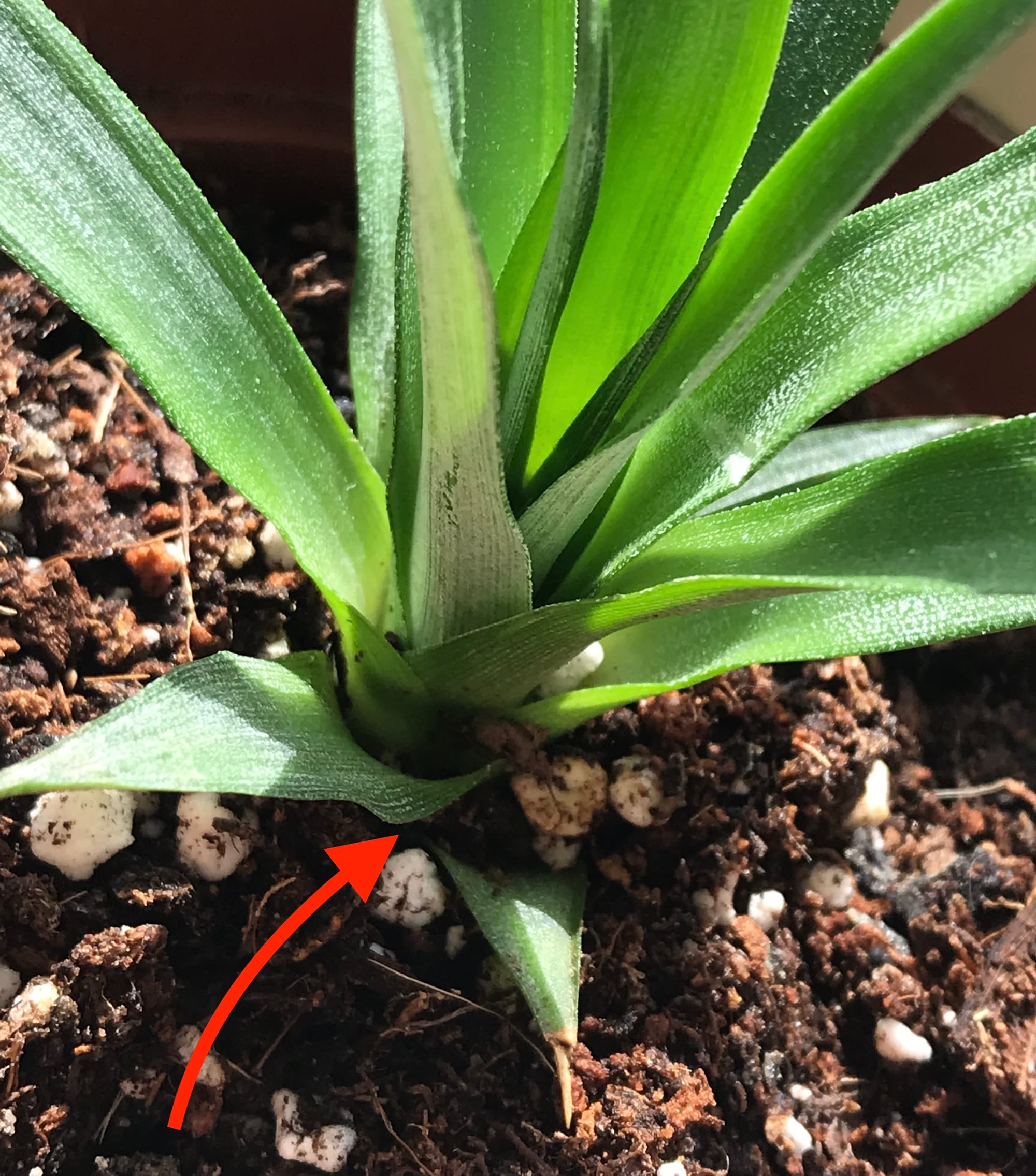 When repotting, ensure its 'crown' isn't submerged with soil as this may cause bacterial rot with trapped moisture in the foliage's cubbyholes.
When repotting, ensure its 'crown' isn't submerged with soil as this may cause bacterial rot with trapped moisture in the foliage's cubbyholes.
Pests & Diseases
Keep an eye out for mealybugs, spider mites, scale, thrips & root mealybugs that'll locate themselves in the cubbyholes and undersides of the leaves, with the exception of the latter in soil. Common diseases associated with Pineapple Plants are root rot, leaf-spot disease, marbling, Phytophthora heart rot, botrytis, rust, powdery mildew & southern blight - click here to learn more about these issues.
Toxicity
Not known to be poisonous when consumed by pets and humans. If large quantities are eaten, it may result in vomiting, nausea and a loss of appetite. Although the leaves may look delicate from online pictures, its foliage and flowers can be very sharp, acting like small Swiss-army knives.
Retail Locations
Online Stores.
Book a 1-to-1 Call with THE HOUSEPLANT DOCTOR™
If you need further advice with your houseplants, book an advice call with ukhouseplants' friendly and expert writer today! This can be done via a video or audio call on most apps, including Facebook, FaceTime & Skype. A ten-minute call costs £5.99 (US$7), or £15.99 for thirty minutes. You can ask multiple questions, including queries on plants, pests, terrariums, repotting advice and anything in between. Please consider supporting this service to keep ukhouseplants thriving!